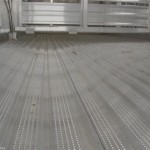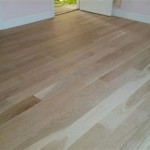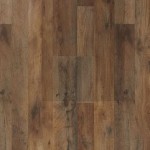Bamboo Flooring: Understanding and Addressing Water Stains
Bamboo flooring has gained considerable popularity as a sustainable and aesthetically pleasing alternative to traditional hardwood. Renowned for its durability and unique grain patterns, bamboo offers a natural and sophisticated appearance in residential and commercial spaces. However, like any natural flooring material, bamboo is susceptible to water damage. When water infiltrates the surface, it can lead to unsightly stains that detract from the floor's beauty and potentially compromise its structural integrity. Understanding the causes of water stains, implementing preventative measures, and learning effective removal techniques are crucial for maintaining the longevity and visual appeal of bamboo flooring.
The composition of bamboo flooring plays a significant role in its vulnerability to water stains. Bamboo stalks are processed and manufactured into planks, typically using either vertical, horizontal, or strand-woven constructions. The density and method of construction influence the porosity of the material. Horizontal and vertical bamboo flooring, characterized by visible knuckles from the bamboo stalk, tends to be more porous than strand-woven bamboo. Strand-woven bamboo, which is created by shredding the bamboo and compressing the fibers under intense pressure, boasts a higher density and therefore greater resistance to water absorption. Regardless of the construction type, any prolonged exposure to moisture can seep into the fibers, resulting in discoloration and staining.
The finish applied to bamboo flooring provides a critical layer of protection against water damage. Factory-applied finishes, typically consisting of multiple coats of polyurethane or similar sealants, create a barrier that repels water and prevents it from penetrating the bamboo itself. However, this protective layer is not impenetrable. Scratches, abrasions, and wear over time can compromise the integrity of the finish, leaving the bamboo vulnerable to moisture. Furthermore, if the finish is not properly maintained or if spills are not promptly addressed, water can seep through imperfections and cause staining. The type of finish also matters; some finishes are more water-resistant than others. Consulting with flooring professionals and carefully selecting a finish that suits the specific needs of the environment is essential.
Identifying and Categorizing Water Stains
Effective treatment of water stains begins with accurate identification and categorization of the stain. Water stains on bamboo flooring can manifest in various forms, ranging from light discoloration to dark, prominent marks. The appearance of the stain and the likely cause will dictate the most appropriate removal method. Early detection and prompt intervention are crucial to minimizing the damage and preventing permanent staining. Regular inspection of the flooring, particularly in high-moisture areas like kitchens and bathrooms, can help identify potential problems before they escalate.
Superficial water stains are often characterized by a light, cloudy appearance on the surface of the bamboo. These stains typically occur when water is left to sit on the floor for a short period, such as a spill that is not immediately cleaned up. The water penetrates the finish but does not reach the underlying bamboo fibers. Superficial stains are generally easier to remove and may respond well to basic cleaning methods. However, if left untreated, they can eventually penetrate deeper and become more difficult to address.
Deeper water stains present a more significant challenge. These stains are typically darker in color and may appear as rings or blotches on the flooring. They are caused by prolonged exposure to water, allowing the moisture to infiltrate the finish and reach the bamboo fibers. Deep stains can be more difficult to remove because the water has already altered the color of the bamboo itself. In some cases, professional refinishing may be required to completely eliminate the stain.
Dark water stains, sometimes almost black, can also be a sign of mold or mildew growth within the bamboo. These stains indicate a significant moisture problem and require immediate attention. Mold and mildew not only cause discoloration but can also pose health risks. Addressing dark water stains involves not only removing the stain but also identifying and eliminating the source of moisture to prevent recurrence. Professional assessment and remediation may be necessary in severe cases.
Preventative Measures to Minimize Water Stain Risk
Prevention is paramount when it comes to protecting bamboo flooring from water stains. Proactive measures can significantly reduce the risk of water damage and maintain the floor's pristine appearance. Implementing a combination of preventative strategies is the most effective approach to safeguarding the investment in bamboo flooring.
Prompt spill cleanup is essential. Any liquids spilled on the bamboo flooring should be immediately wiped up with a clean, dry cloth. Avoid letting spills sit for extended periods, as this increases the likelihood of water penetrating the finish and causing stains. Keep absorbent cloths or paper towels readily available in areas prone to spills, such as kitchens and dining rooms.
Maintaining the finish is crucial for water resistance. Regularly inspect the finish for scratches, abrasions, and signs of wear. If the finish is damaged, it should be promptly repaired or refinished to prevent water from penetrating the bamboo. Apply a new coat of finish as recommended by the manufacturer to maintain its protective properties. Avoid using harsh cleaning products that can strip or damage the finish.
Controlling humidity levels can also prevent water stains. Excessive humidity can cause condensation on the floor surface, leading to moisture absorption and staining. Use dehumidifiers in areas with high humidity, such as basements and bathrooms. Ensure adequate ventilation in these areas to minimize moisture buildup. Avoid using excessive amounts of water when cleaning the floor.
Using protective mats and rugs in high-traffic areas and near water sources provides an additional layer of defense. Place mats at entryways to trap dirt and moisture from shoes. Use rugs in areas where spills are likely to occur, such as under sinks and near dishwashers. Regularly clean and maintain these mats and rugs to prevent them from becoming sources of moisture themselves.
Effective Stain Removal Techniques
When water stains do occur, prompt and appropriate removal techniques are essential to minimize the damage. The specific method used will depend on the type and severity of the stain. Always test any cleaning solution on an inconspicuous area of the floor before applying it to the entire stain to ensure that it does not cause discoloration or damage.
For superficial water stains, a mild cleaning solution may be sufficient. Mix a small amount of dish soap with warm water and gently wipe the stained area with a soft cloth. Avoid using abrasive cleaners or scrub brushes, as these can scratch the finish. Rinse the area with clean water and dry thoroughly with a clean cloth. Repeat the process if necessary until the stain is removed.
For deeper water stains, a solution of vinegar and water may be more effective. Mix equal parts white vinegar and water and apply the solution to the stained area with a soft cloth. Allow the solution to sit for a few minutes, then gently wipe the area with a clean cloth. Rinse the area with clean water and dry thoroughly. Vinegar is a mild acid that can help to break down the stain, but it should be used cautiously as it can also damage the finish if left on for too long.
Hydrogen peroxide can be used for stubborn water stains, but it should be used with extreme caution as it can lighten the color of the bamboo. Dilute the hydrogen peroxide with water (a 3% solution is recommended) and apply it to the stained area with a cotton ball or soft cloth. Allow the solution to sit for a few minutes, then gently wipe the area with a clean cloth. Rinse the area with clean water and dry thoroughly. Monitor the area closely to ensure that the hydrogen peroxide does not cause excessive lightening or discoloration.
In some cases, a paste of baking soda and water can be used to remove water stains. Mix baking soda with enough water to form a thick paste. Apply the paste to the stained area and allow it to dry completely. Once the paste is dry, gently wipe it away with a clean cloth. Rinse the area with clean water and dry thoroughly. Baking soda is a mild abrasive that can help to lift the stain from the bamboo fibers.
For dark water stains that may indicate mold or mildew growth, a solution of bleach and water may be necessary. However, bleach should be used with extreme caution as it can damage the finish and cause discoloration. Dilute the bleach with water (a ratio of 1 part bleach to 10 parts water is recommended) and apply the solution to the stained area with a soft cloth. Allow the solution to sit for a few minutes, then gently wipe the area with a clean cloth. Rinse the area thoroughly with clean water and dry completely. Ensure adequate ventilation during and after the cleaning process. If the mold or mildew persists, professional remediation may be required.
If the water stain is severe and cannot be removed with home remedies, professional refinishing may be necessary. Refinishing involves sanding down the existing finish and applying a new coat of sealant. This process can effectively remove the stain and restore the floor to its original beauty. However, refinishing is a more involved and costly process than other stain removal methods. Consulting with a flooring professional is essential to determine if refinishing is the best option for the specific situation.
Maintaining bamboo flooring's beauty and longevity requires vigilance and proactive care. Understanding the causes of water stains, implementing preventative measures, and learning effective removal techniques are essential for protecting the investment. Regular inspection, prompt spill cleanup, and proper maintenance of the finish can significantly reduce the risk of water damage. When stains do occur, prompt and appropriate treatment is crucial to minimize the damage and prevent permanent discoloration. While DIY methods can often be effective for superficial stains, professional assistance may be necessary for more severe or persistent stains. By following these guidelines, bamboo flooring can retain its natural beauty and provide years of durable and aesthetically pleasing performance.

Problems With Bamboo Flooring Water Damage The Company

Remove Water Marks And Greasy Stains From Hardwood Floors

Remove Water Stains On Hardwood Floors Homes Stain Wood Furniture Diy Cleaner

Restoring Bamboo Furniture And Floors That Have Suffered Water Damage The Bazaar

Is Bamboo Flooring Water Resistant The Company

How To Remove Water Stains From Wood Floors Discount Flooring Depotdiscount Depot Blog

Electrodry Bamboo Floor Restoration Gorgeous Floors In 1 Day Without The Sanding Mess

The Proper Way To Clean Bamboo Floors

How To Remove Water Stains From Wood Use This Viral

Bubbles In A Strand Bamboo Floor Create Sticky Mess Wood Business
Related Posts








